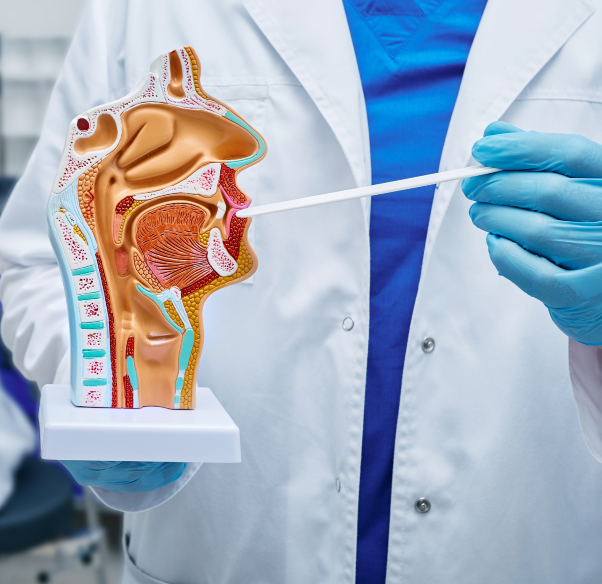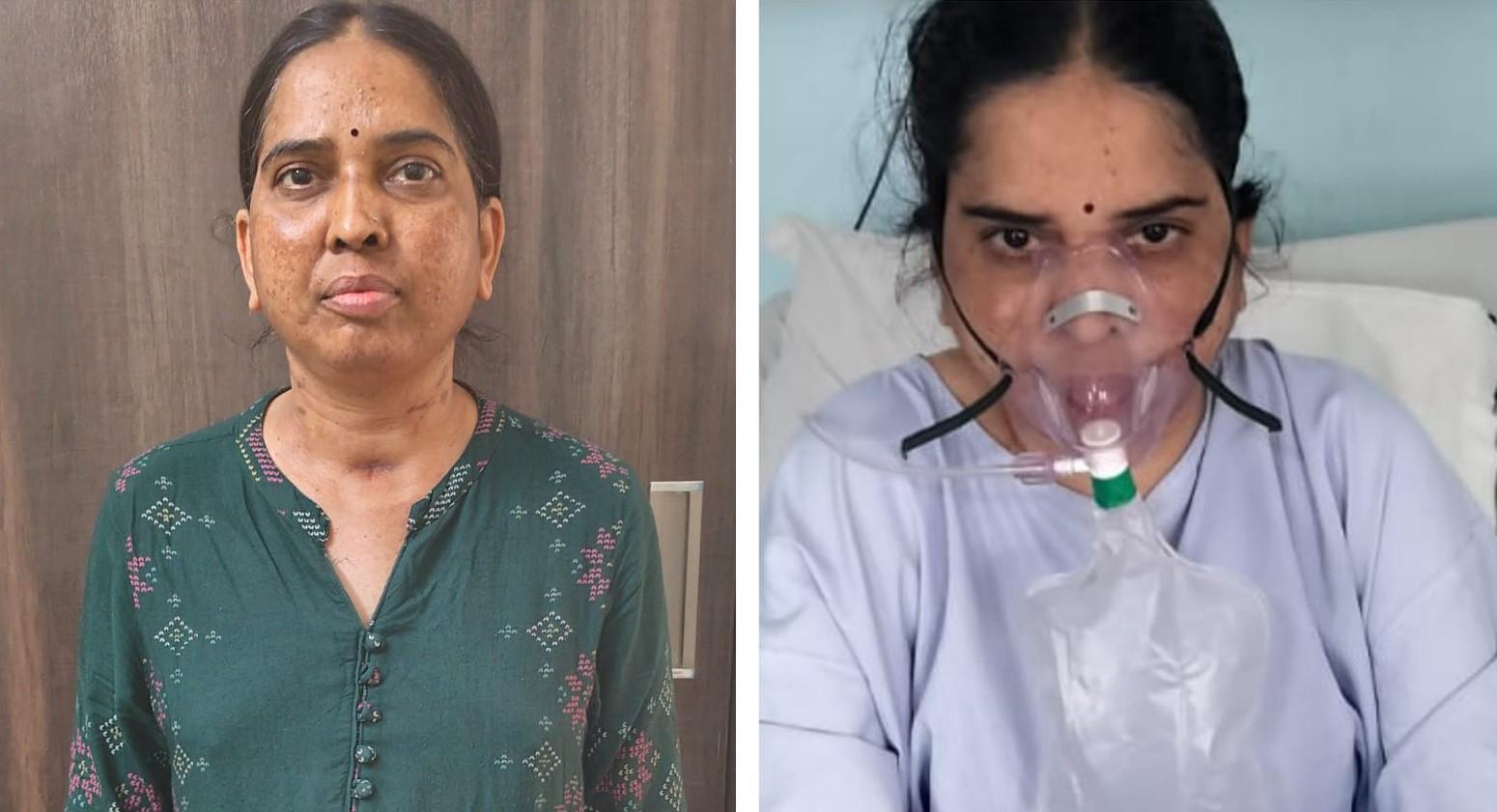Symptoms:
Sinusitis manifests with a range of symptoms, which may include:
- Nasal Congestion: Blockage or difficulty breathing through the nose.
- Facial Pain or Pressure: Discomfort in the forehead, cheeks, or around the eyes.
- Headaches: A persistent ache or pressure in the head.
- Discolored Nasal Discharge: Mucus that may be green or yellow.
- Reduced Sense of Smell and Taste: Impaired olfactory functions.
- Coughing: Particularly worsened at night.
- Fatigue: Generalized feeling of tiredness and malaise.
Causes:
Several factors can contribute to sinusitis, including:
- Viral Infections: Common colds or influenza viruses.
- Bacterial Infections: Secondary infections following a viral illness.
- Allergies: Reactions to airborne allergens.
- Nasal Polyps: Small growths in the nasal passages.
- Deviated Septum: Structural abnormalities in the nasal cavity.
Treatment:
Management strategies for sinusitis depend on the underlying cause and the duration of symptoms:
- Home Remedies: Adequate hydration, rest, and humidification can provide relief.
- Nasal Irrigation: Saline nasal sprays or irrigations help clear mucus and reduce inflammation.
- Decongestants: Over-the-counter or prescription medications can alleviate nasal congestion.
- Antibiotics: If bacterial infection is confirmed, a course of antibiotics may be prescribed.
- Corticosteroids: Nasal corticosteroid sprays can reduce inflammation.
- Allergy Medications: Antihistamines may be beneficial in sinusitis caused by allergies.
- Surgery: In cases of chronic or recurrent sinusitis, surgical interventions, such as endoscopic sinus surgery, may be considered to improve drainage and alleviate symptoms.
Understanding the symptoms, identifying the underlying causes, and tailoring treatment to the specific type of sinusitis are essential for effective management. Individuals experiencing persistent or severe symptoms should seek medical evaluation for a comprehensive diagnosis and personalized treatment plan.
Sinusitis is a common inflammatory condition that affects the sinuses, the hollow cavities around the nasal passages. Characterized by inflammation and swelling of the sinus linings, sinusitis can be acute or chronic. Common causes include viral or bacterial infections, allergies, and nasal polyps. Individuals with sinusitis often experience symptoms such as nasal congestion, facial pain or pressure, headaches, and a persistent feeling of mucus drainage.
Symptoms:
- Sore Throat: Persistent discomfort or pain in the throat.
- Swollen Tonsils: Enlarged, red, and sometimes coated tonsils.
- Difficulty Swallowing: Discomfort or pain while swallowing.
- Fever and Chills: Systemic signs of infection, often accompanied by fever.
- Tender Neck Glands: Swollen and tender lymph nodes in the neck.
Causes:
Tonsillitis is primarily caused by viral or bacterial infections, with the most common culprits being the influenza virus or streptococcal bacteria. The condition is highly contagious and often spreads through respiratory droplets, particularly in crowded or close-contact environments. Chronic tonsillitis may be linked to persistent bacterial infections or recurring episodes of acute tonsillitis.
Treatment:
- Viral Tonsillitis: Typically resolves on its own, with treatment focused on relieving symptoms through rest, hydration, and over-the-counter pain relievers.
- Bacterial Tonsillitis (Strep Throat): Requires antibiotics to eliminate the bacterial infection and prevent potential complications.
- Symptomatic Relief: Warm saltwater gargles, throat lozenges, and adequate hydration can provide relief from symptoms.
- Surgical Intervention: In cases of recurrent or chronic tonsillitis, a tonsillectomy may be recommended, involving the surgical removal of the tonsils.
Tonsillitis is a common condition, particularly among children, and understanding its symptoms and appropriate treatment options is crucial for effective management and prevention of complications. Seeking medical advice for a proper diagnosis and tailored treatment plan is essential for individuals experiencing recurrent or severe tonsillitis episodes.
Tonsillitis is a prevalent inflammatory condition characterized by the swelling and inflammation of the tonsils, which are located at the back of the throat. Typically caused by viral or bacterial infections, particularly the streptococcal bacteria, tonsillitis commonly presents with symptoms such as a sore throat, difficulty swallowing, and enlarged, red tonsils. Individuals affected may also experience systemic signs like fever and tender neck glands.
Symptoms:
Nasal congestion, commonly referred to as a stuffy or blocked nose, is characterized by difficulty breathing through the nostrils. Common associated symptoms include:
- Difficulty Breathing: Limited airflow through the nasal passages.
- Runny Nose: Excessive nasal discharge, often clear or thick.
- Sneezing: Frequent or persistent sneezing.
- Sinus Pressure: Feeling of fullness or discomfort around the forehead and cheeks.
- Reduced Sense of Smell: Impaired olfactory function may accompany nasal congestion.
Causes:
Nasal congestion can be attributed to various factors, including:
- Viral Infections: Common cold or influenza viruses often lead to nasal congestion.
- Allergies: Exposure to allergens like pollen, dust, or pet dander can trigger congestion.
- Sinusitis: Inflammation of the sinuses due to infections or other factors.
- Environmental Irritants: Tobacco smoke, pollution, or strong odors may contribute to nasal congestion.
- Structural Issues: Deviated septum or nasal polyps can obstruct nasal passages.
Treatment:
Addressing nasal congestion involves targeted interventions based on the underlying cause. Common treatment options include:
- Decongestants: Over-the-counter or prescription medications to reduce nasal swelling and promote airflow.
- Antihistamines: Effective for congestion caused by allergies, these medications block histamine responses.
- Nasal Sprays: Saline nasal sprays or corticosteroid nasal sprays to alleviate congestion and reduce inflammation.
- Steam Inhalation: Breathing in steam from a bowl of hot water can help open nasal passages.
- Hydration: Staying well-hydrated helps thin mucus and ease congestion.
- Avoiding Irritants: Minimizing exposure to smoke, pollutants, or allergens can prevent aggravating congestion.
Understanding the symptoms and underlying causes of nasal congestion is crucial for implementing effective treatment strategies. While many cases can be managed with over-the-counter remedies, persistent or severe congestion may require medical evaluation to address the root cause and ensure optimal nasal health.
Nasal congestion, commonly known as a stuffy or blocked nose, is a prevalent condition characterized by the inflammation and swelling of the nasal tissues, leading to difficulty in b.reathing through the nostrils. Often caused by viral infections, allergies, or environmental irritants, nasal congestion can result in a range of symptoms, including a runny or stuffy nose, sneezing, and difficulty in smelling.
Symptoms of Hearing Loss
- Difficulty Understanding Speech: Particularly in noisy environments or when multiple people are speaking.
- Frequently Asking for Repetitions: Needing others to repeat themselves or speak more loudly.
- Muffled Hearing: Sounds may seem distant or unclear, like listening through a barrier.
- Tinnitus: Ringing, buzzing, or hissing sounds in the ears that are not caused by external sources.
- Turning Up the Volume: Increasing the volume on televisions, radios, or phones more than usual.
- Withdrawal from Conversations: Avoiding social situations or feeling frustrated during conversations.
Causes of Hearing Loss
- Age-Related Hearing Loss (Presbycusis): Gradual loss of hearing that occurs as part of the aging process.
- Noise-Induced Hearing Loss: Damage to the inner ear caused by prolonged exposure to loud noises, such as machinery, music, or traffic.
- Ear Infections: Infections that affect the middle ear can cause temporary or permanent hearing loss if not treated promptly.
- Ototoxic Medications: Certain medications can damage the inner ear, leading to hearing loss.
- Genetic Factors: Some forms of hearing loss are inherited and can be present at birth or develop later in life.
- Head Trauma: Injuries to the head or ear can damage the structures of the ear, leading to hearing loss.
- Earwax Buildup: Excessive earwax can block the ear canal, causing temporary hearing loss.
- Chronic Diseases: Conditions like diabetes or high blood pressure can contribute to hearing loss.
Treatment for Hearing Loss
- Hearing Aids: Devices that amplify sound, making it easier for individuals with hearing loss to hear. Modern hearing aids are discreet and customizable to individual needs.
- Cochlear Implants: Surgical implants that bypass damaged parts of the ear and directly stimulate the auditory nerve, suitable for severe hearing loss.
- Medication: For hearing loss caused by infections or inflammations, medications such as antibiotics or steroids may be prescribed.
- Surgery: Surgical interventions may be necessary to repair structural problems, remove tumors, or drain fluid from the ear.
- Assistive Listening Devices: These devices help improve hearing in specific situations, such as phone conversations or watching television.
- Earwax Removal: Professional removal of earwax can restore hearing in cases where blockage is the cause.
- Hearing Rehabilitation: Counseling and training to help individuals with hearing loss adapt to their condition, using speech reading, communication strategies, and assistive technology.
- Preventive Measures: Wearing ear protection in noisy environments and avoiding prolonged exposure to loud sounds can prevent further hearing damage.
Early diagnosis and treatment are crucial for managing hearing loss effectively. Regular hearing check-ups, particularly for those at risk, can help catch issues early and provide the best possible outcomes.
Hearing loss is a common condition that affects millions of people worldwide, impacting their ability to communicate and engage in everyday activities. It can range from mild to severe and may affect one or both ears. Hearing loss can occur at any age and can be temporary or permanent, depending on the underlying cause. Understanding the symptoms, causes, and available treatment options is essential for managing and improving quality of life.
Symptoms
- Loud snoring, often noticed by others
- Episodes of breathing cessation during sleep, observed by a partner
- Sudden awakenings with a sensation of gasping or choking
- Excessive daytime sleepiness (hypersomnia)
- Morning headaches
- Difficulty concentrating during the day
- Irritability and mood changes
- Dry mouth or sore throat upon waking
- Restless sleep or frequent nighttime awakenings
Causes
- Obesity: Excess weight, especially around the neck, can obstruct the airway, leading to OSA.
- Anatomical Features: Enlarged tonsils, a large tongue, a small jaw, or a deviated septum can narrow the airway.
- Aging: The risk of sleep apnea increases with age, as muscle tone decreases, particularly in the upper airway.
- Family History: Genetics may play a role, as sleep apnea can run in families.
- Use of Sedatives: Medications that relax the muscles, such as sleeping pills or alcohol, can exacerbate sleep apnea.
- Smoking: Smoking can increase inflammation and fluid retention in the upper airway.
- Medical Conditions: Conditions like congestive heart failure, high blood pressure, and type 2 diabetes are associated with an increased risk of sleep apnea.
Treatment
- Lifestyle Changes: Weight loss, exercise, avoiding alcohol, quitting smoking, and sleeping on your side can significantly improve symptoms.
- Continuous Positive Airway Pressure (CPAP): A common treatment that involves wearing a mask over the nose or mouth during sleep. The mask is connected to a machine that delivers a continuous stream of air, keeping the airway open.
- Oral Appliances: Devices fitted by a dentist that reposition the jaw or tongue to keep the airway open.
- Surgery: In cases where other treatments are ineffective, surgical options like uvulopalatopharyngoplasty (UPPP), tonsillectomy, or jaw repositioning surgery may be recommended.
- Positional Therapy: For some people, sleeping on their back can worsen sleep apnea, so positional therapy encourages sleeping in a different position.
- Treatment of Underlying Conditions: Managing conditions like hypothyroidism, nasal congestion, or allergies that may contribute to sleep apnea.
Early diagnosis and effective management of sleep apnea are crucial to improving sleep quality and preventing associated health risks such as cardiovascular disease, hypertension, and stroke. If you suspect you or a loved one has sleep apnea, consult a healthcare provider for a proper evaluation and treatment plan.
Sleep apnea is a common and potentially serious sleep disorder in which breathing repeatedly stops and starts during sleep. This condition can lead to disrupted sleep patterns, reducing the quality of sleep and contributing to various health complications. There are three main types of sleep apnea: obstructive sleep apnea (OSA), the most common form; central sleep apnea (CSA), which involves the brain not sending proper signals to the muscles that control breathing; and complex sleep apnea syndrome, a combination of both.





























